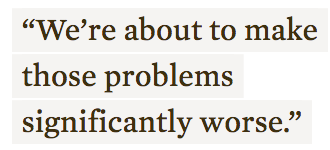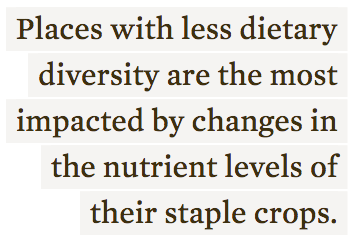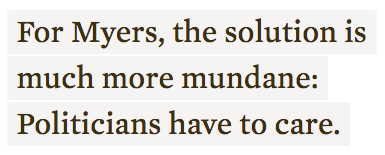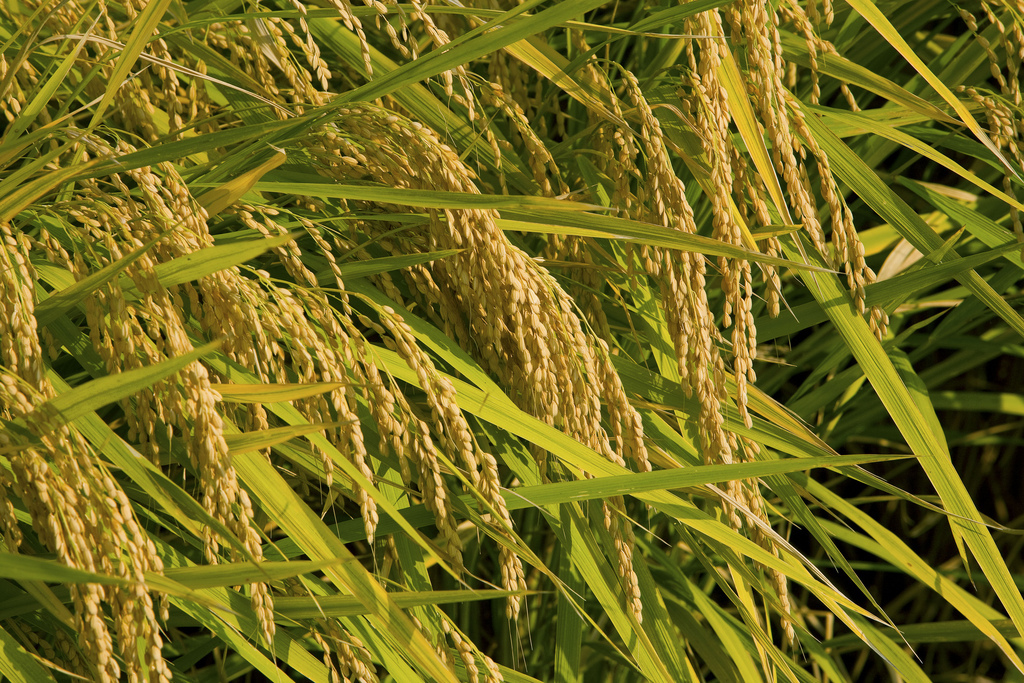New Food Economy: We already know climate change will make our crops less nutritious. Now we know how that will impact our health
by H. Claire Brown | August 27th, 2018
A new study shows this nutrient decline will mean that, by 2050, an additional 175 million people worldwide will be deficient in zinc, and 122 million more won’t be eating enough protein.
It’s been almost exactly one year since Hurricane Harvey wrought havoc in Texas and Louisiana, shattering storm records and dumping more than 60 inches of rain on the region over the course of its six-day rampage. At the time, we were reporting on cattle rescue operations and the food safety hazards to expect after power outages. Many other media outlets were quick to link the unprecedented scale of the flooding in Houston to climate change. One scientist told The Atlantic that up to 30 percent of Harvey’s total rainfall could be attributed to climate change caused by humans.
When we talk about the impacts of climate change on food security, major weather events like hurricanes tend to get a lot of air time. It makes sense—they’re dramatic, they’re tangible, and the economic impacts are relatively simple to measure. Last year, for instance, natural disasters cost the United States agricultural sector more than $5 billion.
 But a growing body of research is starting to show that, beyond the droughts and floods we already expect from climate change, we’re also in for a change in the nutrient content of the food crops we rely on every day. Increased levels of carbon dioxide in the atmosphere will affect plant growth and suppress the levels of zinc, iron, and protein in staple crops.
But a growing body of research is starting to show that, beyond the droughts and floods we already expect from climate change, we’re also in for a change in the nutrient content of the food crops we rely on every day. Increased levels of carbon dioxide in the atmosphere will affect plant growth and suppress the levels of zinc, iron, and protein in staple crops.
According to a study released Monday in the journal Nature, this nutrient decline will mean that, by 2050, an additional 175 million people worldwide will be deficient in zinc, and 122 million more won’t be eating enough protein. Worse, 1.4 billion women and children under the age of five, who are living in countries with increased rates of anemia, stand to lose an additional 4 percent of their dietary iron intake. “You’ve got this baseline of a couple billion people suffering from deficiencies,” says Dr. Sam Myers, the Harvard researcher who led the study. “Iron and zinc deficiency together have [already] been estimated to cause 63 million life-years lost annually, and we’re about to make those problems significantly worse.”
In 2014, Myers published another study that looked at the effects of increased carbon dioxide on plant growth. Previous experiments had largely been conducted in greenhouses or indoor settings and many plant scientists argued that any changes in nutrients resulted from the artificial environment, not necessarily from increased carbon dioxide. So Myers and his colleagues collaborated to conduct tests outdoors. They set up rings of carbon dioxide-emitting pipes aimed inward and grew plants on both the inside and the outside of the circle. That way, they could show more definitively that any nutrient disparities between the plants inside the ring of pipes and the control group outside the circle resulted from carbon dioxide. They grew 41 cultivars of six food crops on three continents over 10 years, and found that increased carbon dioxide levels led to decreased levels of iron and zinc in every crop they grew. Protein levels decreased in grains, but legumes weren’t as affected. Other vitamins and minerals were less consistent—some increased, some decreased.
 But what kind of an impact might these changes have on human health? That’s where the new research comes in. “It’s quite a big chunk of work, because you need to estimate what the populations of most of the countries all over the world are eating on a daily basis, and what the nutrient content of each one of those foods is, in order to calculate their total daily intake of each nutrient and how each crop is contributing to it,” Myers says.
But what kind of an impact might these changes have on human health? That’s where the new research comes in. “It’s quite a big chunk of work, because you need to estimate what the populations of most of the countries all over the world are eating on a daily basis, and what the nutrient content of each one of those foods is, in order to calculate their total daily intake of each nutrient and how each crop is contributing to it,” Myers says.
The team built a giant database that looks at the per-capita consumption of 225 foods for the populations of 152 countries. That’s called the Global Extended Nutrient Supply Database, and it was published in 2016. To build it, the team used baseline estimates from the Food and Agriculture Organization of the United Nations (these are calculated by measuring the food production of a country, adding its imports, and subtracting its exports. The results are a rough estimate of how much is eaten by the country’s residents). They added multiple layers of data—for instance, they split up the category called “fruit” to distinguish between bananas and mangoes, and incorporated more detailed trade reports. They also included the findings from dietary surveys conducted by researchers at Tufts University in Massachusetts.
When they were finished, they had what Myers calls a “unified set of assumptions.” That means they could look at what a 14-year-old boy typically eats in Brazil in a day, cross-reference it with the projected decline in crop nutrition by 2050, and use that information to figure out how he might be impacted by a decrease in the protein levels of the rice he eats daily. It’s pretty granular detail that relies on a lot of assumptions, but it’s the best method we have right now for calculating the impact of a changing food supply on our growing population.
 Myers’s team found that places with less dietary diversity are the most impacted by changes in the nutrient levels of their staple crops. It makes sense: If you eat only bread and that bread gets less nutritious, you’re going to suffer more than if you eat bread three times a week and supplement your diet with vegetables, fruit, and meat.
Myers’s team found that places with less dietary diversity are the most impacted by changes in the nutrient levels of their staple crops. It makes sense: If you eat only bread and that bread gets less nutritious, you’re going to suffer more than if you eat bread three times a week and supplement your diet with vegetables, fruit, and meat.
India, Sub-Saharan Africa, and parts of South Asia were some of the most vulnerable regions the researchers looked at. In parts of the world where people are already struggling to eat enough micro and macronutrients, the depleted nutritional value of cheap, easily accessible dietary staples makes matters worse. “Iron deficiency causes stunting so you don’t achieve your growth potential. It can impact IQ, and it can lead to significantly reduced work capacity. In these countries where work is often manual labor in agriculture settings, that can mean a significant impact on income, which then, of course, has an additional knock on health effects,” Myers says. “You’re just weaker as a result.”
Though advocates of genetic modification have long pointed toward advances in technology as the solution to the problem, we’ve yet to see large-scale success from miracle products like Golden Rice. For Myers, the solution is much more mundane: Politicians have to care. “I don’t feel hopeless about addressing this problem, except that there’s so little government support within our country or abroad to really ramp up an international research agenda,” he says. “If we were really committed as an international community, then I think this is a problem that could be addressed.”
